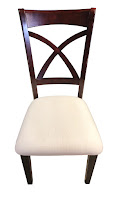 |
| Chair After |
 |
| Chair Before |
This chair was a challenge. Not only because there was a lot of fabric to replace, the chair was also very heavy. My estimate for this chair was that it was made in the late 1920's to early 1930's, based on the original material of which I found a small scrap on either side of the arm padding. The wood was cherry.
Once I removed all the sections of the chair, (you start on the back, which is the last section added to a chair) I removed the seat stuffing, which consisted of horse hair and straw. This is another clue as to the age of this chair. Prior to modern-day foam and fiber fill, upholsterers used horse hair and straw for the seat. Once I removed the nasty chair stuffing, it exposed the springs. The seat springs were in pretty good shape, but needed some overall tightening and re-tying, but not a complete eight-way tie. The back of the chair also had springs, which were in good condition.
The chair had the original webbing on the underside, but the most recent upholsterer attached new webbing to the bottom to strengthen the integrity of the springs without removing the springs. I usually remove the chair's springs and replace the webbing when necessary, but this chair was in good enough shape with the original springs, thus needed a bit of extra tying. Once the springs were secured, I covered them with premium muslin instead of burlap. This allowed me to really pull and tighten the springs to keep them in place for the next step, which is adding the padding. Since this particular chair had a bit of wood showing, I touched up the wood with matching stain and used satin polyurethane to protect it. This is done prior to adding material.
The first layer of padding was a section of raw cotton, which comes on a large roll and can be pulled apart and placed directly on the chair's seat. The next layer was a 1" section of premium foam, then another layer of raw cotton. All these seat toppers were finished with another section of muslin which holds everything together and gives the chair its "crown," where it is higher in the middle section. The springs were held tightly and the bounce was perfect.
Fabric was next. My customer chose a lovely Kelly Ripa Home fabric with a nice design. After careful measuring, I covered the seat first with the material. Once I was satisfied with the seat, I chose to do the arms next. I stapled foam to the top of the arms and Dacron to the sides. This formed a nice cushion to support the arms without a lot of bulk. Using the chair's arms for measurement, I cut the right amount of material to each arm, attaching it from the back side to the front of the arm then pulling it back before attaching it to the back of the chair. I chose to do the arms prior to doing the interior back so that I had easy access to it.
The back proved challenging because this chair was fairly large, so a generous section of fabric was required to cover it. I wrapped the fabric around to the back of the chair, curving at the top edges instead of the original style which was made with side inserts and welting. Each upholsterer does things a little differently. Once the fabric was firmly in place, the buttons were next. I made each button using a button kit that covers the metal button fixtures with the same fabric as the rest of the item.
The buttons are pulled through the thick front to the back using extra long needles, then tied off in the back of the chair through the webbing. This is a tricky procedure because you are going through about 6"-8" of material and padding to reach the back. I use a strong waxed thread for added strength. I chose to put the buttons in a different configuration than the original (personal choice) which I felt matched the design of the chair better.
After the buttons were in place, I stapled and nailed "curve ease" to the back edge of the chair so that I could attach the fabric, then it gets hammered it in place to cover the hardware that attaches it. I glued double welting to the arm fronts for clean finish. Once the entire chair was done, I stapled chambray to the underside. This is a "dust cover" to protect the chair from dirt and debris that can enter from the underside of the seat. It's a good way to finish off a chair. I love the way it turned out and boy, was it comfortable!















































